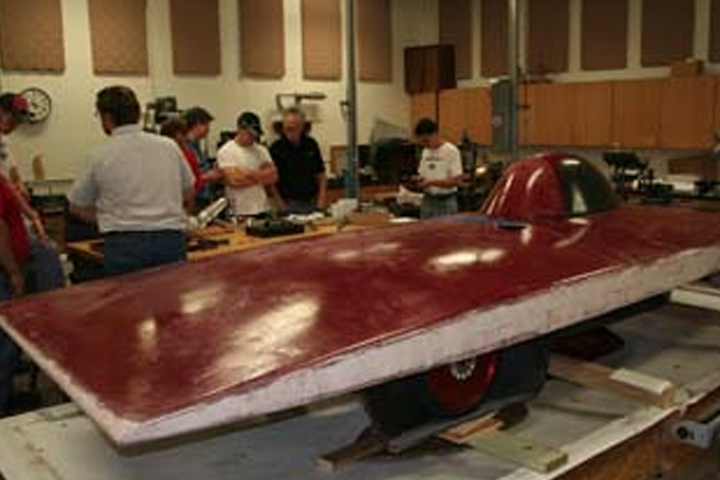Turning sunlight into life lessons is the aim of the Solar Car Challenge.
Illinois State’s own Team Mercury entered a brand new solar-powered vehicle in hopes of running the American Solar Challenge, a 1,650-mile race that made a pit stop in Normal Wednesday, July 18, beginning in the afternoon at the parking lot of Locust and School streets. Watch a video about Team Mercury’s efforts.
Physics shop model-maker Jim Dunham advises the team, and helped create the designs being used by more than 30 Illinois State students to build the new vehicle, Mercury IV. According to Dunham, the project provides students with “real-world experience.”
“I’ve had students who worked on Mercury go into job interviews and list what they have done here when asked for experience,” said Dunham. “Employers usually respond with, ‘That is exactly the experience we are looking to find.’ The work we do here transcends the classroom and gives students a hands-on approach to not only building a car, but problem solving, crisis management, and teamwork.”
 For student Cameron Knight, a junior from Wauconda, who is double majoring in engineering and physics, knowledge of Team Mercury drew him to Illinois State. “This car, this challenge is one of the reasons I came to Illinois State,” said Knight, who was the mechanical leader of the project last year, and is COO this year. With plans to get a job in automotive engineering after graduation, Knight said the experience has been incredible and inspiring. “This project is looking toward the future, and we have to look toward the next generation with green and sustainable engineering.”
For student Cameron Knight, a junior from Wauconda, who is double majoring in engineering and physics, knowledge of Team Mercury drew him to Illinois State. “This car, this challenge is one of the reasons I came to Illinois State,” said Knight, who was the mechanical leader of the project last year, and is COO this year. With plans to get a job in automotive engineering after graduation, Knight said the experience has been incredible and inspiring. “This project is looking toward the future, and we have to look toward the next generation with green and sustainable engineering.”
Knight is one of four drivers of the car that went to the qualifying three-day race in Monticello, N.Y., in early July. Once the team qualified, they were able to compete in the 1,650-mile race that stretches from Rochester, N.Y., to St. Paul, Minn., from July 14 to 21, including an overnight stop in Normal July 18 to July 19.
The American Solar Challenge is an international effort that attracts universities across the United States and Canada. Many schools are taking part with student teams, but a lot of those teams send several pieces of the vehicles out for manufacturing. “Our team does almost every piece of the car in house,” said Dunham. “They work on electronics, they weld. In fact, one year they were able to assist a team whose frame cracked during the race because they could weld.”
 Colleges can spend big bucks on solar vehicles, as much as $1.4 million to get a solar car on the road for the race. Illinois State tends to spend somewhere closer to $45,000 with support from different areas of the University and several area business sponsors, according to Physics Professor Dan Holland, one of the Team Mercury faculty advisors.
Colleges can spend big bucks on solar vehicles, as much as $1.4 million to get a solar car on the road for the race. Illinois State tends to spend somewhere closer to $45,000 with support from different areas of the University and several area business sponsors, according to Physics Professor Dan Holland, one of the Team Mercury faculty advisors.
“Not only do we have students from all across campus working on the car, we have support from across campus as well,” said Holland, who noted Team Mercury receives support from the Office of the President, the Office of the Vice President of Finance and Planning, as well as the Department of Physics, the Center for Mathematics, Science and Technology, College of Applied Science and Technology, and the College of Arts and Sciences. “We are a cross-University program.”
More support comes from the Town of Normal, which helps make the “stage stop” impressive. “The teams will all stop at the end of day five. This is the starting point for day six,” said Holland. Last year, the town provided access to one of the aquatic centers and combined the day’s race start with an energy fair from the Children’s Discovery Museum. “Normal won the best stage stop last year, and we hope that happens again,” said Holland.
Team Mercury member Jim Kenevan, a senior from Park Ridge majoring in international business, said having the challenge stop in Normal puts the pressure on for Team Mercury to perform. “In addition to living up to the expectations of our local sponsors and fans, we want to show the other competing schools what Bloomington-Normal is capable of doing,” he said.
This is the fifth year for Team Mercury to race a solar vehicle. Last year, the team placed second at the event known as the Formula Sun Grand Prix at Indianapolis Motor Speedway. Illinois State was able to beat out Northwestern University, their friendly competitors, by 16 laps over the course of the 24-hour event.
Dunham, who joined the 11 students making the trip to New York state this summer for the qualifiers, said his hopes are high for this year’s races. “We’ve designed the body to be lighter and we have a good team,” he said, adding, “What matters most to us, however, is qualifying. That means the students have worked together to achieve something.”

